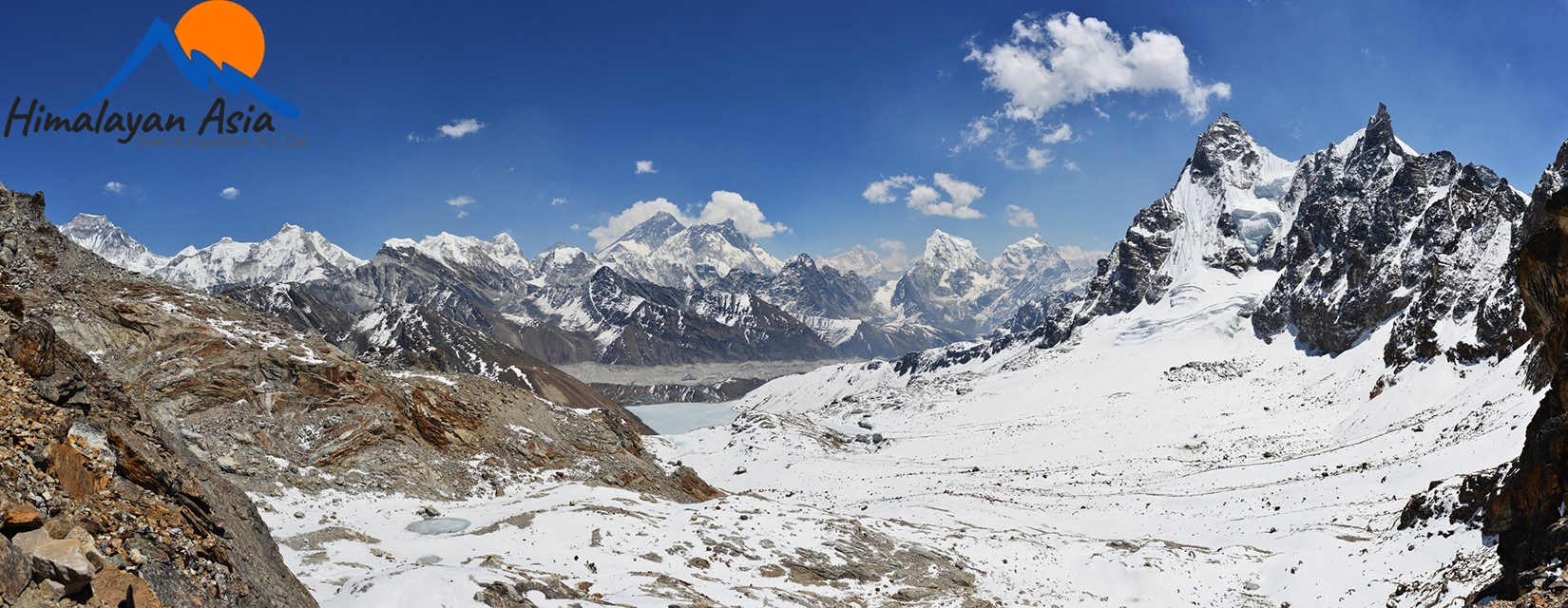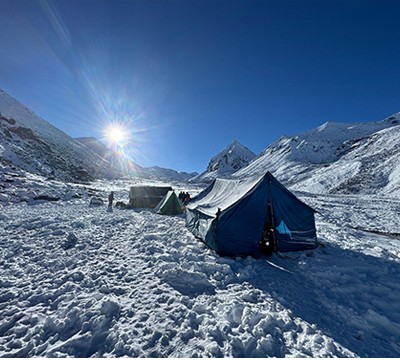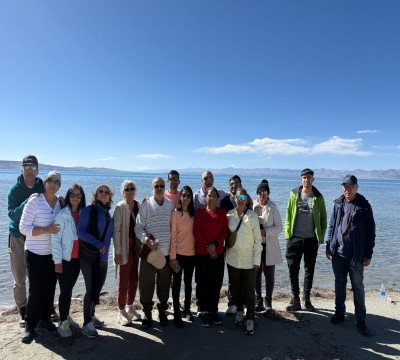Embarking on the Three Passes Trek Everest with Himalayan Asia Treks is an adventure of a lifetime, taking trekkers through some of the most breathtaking landscapes in the Everest region. This Everest Three Passes Trek covers the famous Renjo La Pass, Cho La Pass, and Kongma La Pass, offering panoramic views of iconic peaks like Mount Everest, Lhotse, and Makalu. Along the route, trekkers explore popular villages such as Namche Bazaar, Gokyo, and Dingboche, each rich in Sherpa culture and Himalayan heritage. Highlights include the serene Gokyo Lakes, the dramatic Khumbu Glacier, and the stunning Himalayan vistas from high passes, making it a perfect choice for those seeking both challenge and natural beauty. Whether you’re searching for Three Passes Trek itinerary, Everest Three Passes Trek map, or details about the Three Passes Trek distance and cost, this trek offers an unforgettable journey for adventure enthusiasts and photographers alike.
Popular Places in Three Passes Trek Everest | Everest 3 Passes Trek Highlights
Table of Contents
Popular places in Three Passes Trek Everest
The Everest Three Passes Trek typically begins with a scenic flight from Kathmandu to Lukla, a small mountain airstrip that serves as the gateway to the Khumbu region. From Lukla, trekkers start their journey by following the famous Everest Base Camp Trek , gradually ascending through picturesque villages like Namche Bazaar, Tengboche, and Dingboche. After reaching Everest Base Camp and witnessing the awe-inspiring Khumbu Icefall, trekkers embark on the first of the three passes – Kongma La Pass. This pass offers stunning panoramic views of Everest, Lhotse, Makalu, and other surrounding peaks. From there, the journey continues to Chhukung and eventually reaches the second pass – Cho La Pass. This is a challenging section that often involves crossing glaciers and requires some basic mountaineering skills. Descending from Cho La Pass, trekkers make their way to Gokyo Valley, known for its pristine turquoise lakes and mesmerizing scenery. The third pass, Renjo La Pass, offers breath-taking vistas of Gokyo Lakes, Everest, and other surrounding peaks. The descent from Renjo La Pass takes trekkers through the remote and less-travelled Thame Valley, offering a unique cultural experience as they visit traditional Sherpa villages. The trek eventually re-joins the main Everest Base Camp trail at Namche Bazaar, completing the circular route. Trekkers have the option to trek to Everest Base Camp at this point, or if they've already visited, they can head back towards Lukla airport through familiar terrain.
Throughout the trek, trekkers will have the opportunity to immerse themselves in the local Sherpa culture, staying in teahouses, tasting traditional cuisine, and learning about the spiritual significance of monasteries and stupas that dot the landscape.The Everest Three Passes Trek is a challenging and exhilarating trekking adventure located in the Khumbu region of Nepal, renowned for its stunning mountain landscapes, rich Sherpa culture, and proximity to the world's highest peak, Mount Everest (Sagarmatha in Nepali). This trek is designed for experienced trekkers seeking an extraordinary and immersive journey through the heart of the Himalayas. The Everest Three Passes Trek offers an extraordinary opportunity to traverse three high mountain passes – Kongma La Pass (5,535 meters), Cho La Pass (5,420 meters), and Renjo La Pass (5,360 meters) – each presenting its own unique set of challenges and rewards. Trekkers will be treated to unparalleled views of towering peaks, serene alpine lakes, lush valleys, and charming Sherpa villages as they navigate their way through the rugged terrain
The Everest Three Passes Trek is a physically demanding adventure that requires good physical fitness, proper acclimatization, and some prior trekking experience at high altitudes. The weather and conditions can be unpredictable, especially at the passes, so being well-prepared with appropriate gear and following experienced guides is essential for a safe and successful journey. The Three Passes Trek Everest is a popular choice for experienced trekkers seeking a more adventurous and off-the-beaten-path experience in the Everest region. It takes around 18-21 days to complete the entire circuit, depending on the pace and acclimatization needs of the trekkers. It is important to note that undertaking this trek requires proper planning, physical fitness, and previous trekking experience due to the high-altitude nature and technical challenges of the passes. It is recommended to hire an experienced guide, best local trekking company in Nepal and obtain the necessary permits for the trek.
Overall, the Everest Three Passes Trek is a truly remarkable and unforgettable experience, offering trekkers the chance to explore the hidden gems of the Everest region while pushing their limits and creating lasting memories amidst the world's highest peaks.
Popular places in Everest Three Passes Trek
Lukla Airport:
Lukla Airport, officially known as Tenzing-Hillary Airport, is a small and challenging mountain airstrip situated in Lukla, Nepal. It serves as the gateway to the Everest region and is one of the most famous and unique airports in the world. The airport is perched at an elevation of approximately 2,860 meters (9,383 feet) amidst the Himalayan mountains. Due to its short runway, steep gradient, and unpredictable weather, Lukla Airport is often considered one of the most dangerous airports for pilots and passengers. It is the starting point for many trekkers and climbers embarking on the journey to Everest Base Camp.
Namche Bazaar:
Namche Bazaar is a vibrant and bustling Sherpa town located in the Solu-Khumbu region of Nepal. It serves as a major trading hub and a popular acclimatization stop for trekkers heading to Everest Base Camp. Set against a stunning backdrop of towering mountains, Namche Bazaar offers a blend of traditional Sherpa culture and modern amenities. It's a place where trekkers can rest, acclimatize to the high altitude, enjoy the local cuisine, and explore the surrounding trails. The town features markets, lodges, shops, and even internet cafes, making it a vital resting point for those venturing into the Everest region.
Tengboche Monastery:
Tengboche Monastery, also known as Thyangboche Monastery, is a revered Buddhist monastery situated at an altitude of around 3,867 meters (12,687 feet) in the Everest region of Nepal. It offers breathtaking panoramic views of Himalayan peaks, including Mount Everest, Ama Dablam, and Lhotse. The monastery is not only a spiritual center for locals but also a place of cultural significance for trekkers and climbers on their way to Everest Base Camp. The annual Mani Rimdu festival held here is a major attraction, drawing devotees and tourists alike.
Viewpoint of Namche Bazaar:
The viewpoint of Namche Bazaar, often referred to as the "Everest View Hotel," provides a spectacular panoramic view of the surrounding Himalayan peaks. Situated at a higher elevation above Namche Bazaar, this viewpoint offers trekkers and visitors an opportunity to catch their first glimpse of Mount Everest and other majestic mountains in the region. The viewpoint is a popular early morning hike from Namche Bazaar, and the sunrise over the mountains from this spot is a sight to behold.
Everest Base Camp:
Everest Base Camp is the starting point for climbers seeking to summit Mount Everest, the world's highest peak. It's located at an altitude of approximately 5,380 meters (17,600 feet) above sea level. The base camp itself is a temporary setup, with climbers and expedition teams establishing camps here as they acclimatize and prepare for their ascent. The journey to Everest Base Camp is a popular trekking route for adventurers, offering stunning views of the Himalayan landscape, opportunities to interact with local Sherpa communities, and a sense of accomplishment in reaching this iconic destination. The trek involves navigating through various terrains, including glaciers, moraines, and alpine meadows.
Kala Patthar
Kala Patthar, also known as Kala Patter, is a notable mountain viewpoint in the Everest region of Nepal. It is situated at an elevation of about 5,545 meters (18,192 feet) and offers one of the most iconic and breathtaking panoramic views of Mount Everest (8,848 meters/29,029 feet), as well as other surrounding peaks like Lhotse and Nuptse. Trekkers and mountaineers often visit Kala Patthar to witness the sunrise over the Himalayas, painting the snow-capped peaks with golden hues. The hike to Kala Patthar is a popular side trip on the Everest Base Camp Trek and provides an opportunity to experience the awe-inspiring Himalayan landscape up close. This is the popular place because in Everest Base Camp Trek Return by Helicopter packages the pick-up point is also Kala Patthar and Everest Base Camp Helicopter Tour also land in Kalapatthar.
Kong La Pass:
The Kong La Pass is a high mountain pass located in the Khumbu region of Nepal, near the border with Tibet. It is part of the challenging Three Passes trek, which involves crossing multiple high passes in the Everest region. Kong La Pass offers stunning panoramic views of the surrounding Himalayan peaks and provides a challenging and rewarding trekking experience for those seeking adventure. The pass is often covered in snow and requires proper acclimatization and trekking equipment for a safe journey.
Renjo La Pass:
Renjo La Pass is another significant high mountain pass on the Three Passes trek in the Everest region of Nepal. Situated at an elevation of approximately 5,340 meters (17,520 feet), the pass provides breathtaking views of the Everest and Rolwaling ranges. The trek to Renjo La Pass offers a chance to experience the rich Sherpa culture, picturesque villages, and pristine alpine landscapes. It's a challenging but memorable route for trekkers seeking both natural beauty and cultural immersion. This Renjo La Pass covers in Everest Base Camp Gokyo Lake Trek also.
Cho La Pass:
Cho La Pass is the third high pass on the Three Passes trek in the Everest region. It stands at an elevation of around 5,420 meters (17,782 feet). Crossing Cho La Pass requires negotiating rocky terrain and a glacier, making it a technically demanding section of the trek. Trekkers are rewarded with stunning vistas of towering peaks and the opportunity to explore the Gokyo Valley and Everest Base Camp areas. Proper trekking experience and preparation are crucial for safely traversing Cho La Pass.
Gokyo Lakes and Gokyo Valley:
Gokyo Lakes and Gokyo Valley are situated in the Khumbu region of Nepal and are known for their mesmerizing natural beauty. The Gokyo Valley is home to a series of glacial lakes, collectively known as the Gokyo Lakes, including the famous Dudh Pokhari or Gokyo Lake. The turquoise blue waters of these lakes, surrounded by snow-capped peaks, create a stunning and tranquil landscape. The Gokyo Valley offers a less crowded alternative to the Everest Base Camp trek and provides trekkers with a chance to explore Sherpa culture, alpine scenery, and the challenging yet rewarding Gokyo Ri viewpoint.
Dingboche:
Dingboche is a picturesque village located in the Khumbu region of the Solukhumbu District in Nepal. Situated at an altitude of approximately 4,410 meters (14,469 feet), Dingboche serves as a popular acclimatization stop for trekkers and climbers on their way to Everest Base Camp and other high-altitude destinations in the Everest region. The village offers stunning panoramic views of towering Himalayan peaks, including Ama Dablam and Lhotse. Despite its remote location, Dingboche provides basic facilities such as lodges, teahouses, and shops catering to the needs of trekkers and mountaineers.
Gorakhshep:
Gorakhshep is a high-altitude settlement situated at an elevation of about 5,164 meters (16,942 feet) in the Khumbu region of Nepal. It serves as the final village before Everest Base Camp for trekkers and climbers. Gorakhshep is located at the foot of the Khumbu Glacier and provides accommodation and lodging options for those aiming to ascend Mount Everest. The terrain around Gorakhshep is rugged and barren, characterized by moraine and glacial debris. It is a common base for expeditions to the Everest summit and is often used as a launching point for the challenging climb.
Sherpa Community in Everest:
The Sherpa community is an integral part of the Everest region's culture and history. Sherpas are an ethnic group native to the Himalayan regions of Nepal, including the Everest area. Known for their exceptional mountaineering skills, Sherpas have played a crucial role in assisting climbers and expeditions to reach the summit of Mount Everest. They have a rich cultural heritage, which includes a strong connection to Buddhism, traditional crafts, and a harmonious way of life in harmony with the challenging environment of the high Himalayas. The Sherpa community's contributions to mountaineering have earned them recognition and respect worldwide.
Flora and Fauna in Sagarmatha National Park:
Sagarmatha National Park, encompassing the Everest region, boasts a diverse range of flora and fauna adapted to the harsh mountain environment. The lower altitudes are home to lush forests of pine, fir, juniper, and rhododendron trees. As the altitude increases, the vegetation transitions to alpine meadows and eventually to rocky terrain. Wildlife in the park includes Himalayan tahr, snow leopard, red panda, and various species of pheasants and other birds. The park is also rich in medicinal herbs and alpine plant species that have adapted to survive in the challenging climate.
Culture and Lifestyle in Everest:
The culture and lifestyle in the Everest region are deeply influenced by the Sherpa community's traditions and Buddhist beliefs. Monasteries and stupas are scattered throughout the region, and the sounds of prayer flags fluttering in the wind create a serene atmosphere. Sherpas are known for their warm hospitality, and visitors often have the opportunity to experience their unique way of life by staying in traditional tea houses and interacting with local families. The region's festivals, such as Mani Rimdu, celebrate Buddhist traditions through dance, music, and religious ceremonies. Agriculture, animal husbandry, and mountaineering-related activities are key elements of the local economy and lifestyle.
Itinerary of Three Passes Trek Everest
The Three Passes Trek is a challenging and popular trekking route in the Everest region of Nepal. It takes you through three high mountain passes: Kongma La Pass, Cho La Pass, and Renjo La Pass. This trek offers breathtaking views of the Everest region, including stunning panoramas of Mount Everest itself.
Short Itinerary for the Three Passes Trek
Day 1: Arrival.
Day 2: Fly from Kathmandu to Lukla (2,840m) and trek to Phakding (2,610m-4 hours).
Day 3: Trek to Namche Bazaar (3,440m-6 hours).
Day 4: Acclimatization Day in Namche Bazaar. Take a short hike to explore the surrounding areas and enjoy the views.
Day 5: Trek to Tengboche (3,860m-6 hours).
Day 6: Trek to Dingboche (4,410m-6 hours).
Day 7: Acclimatization Day in Dingboche. Take a hike to Nagarjun Hill or Chhukung Ri for better acclimatization.
Day 8: Trek to Lobuche (4,940m-6 hours).
Day 9: Trek from Lobuche to Gorak Shep (5,170m), and then hike to Everest Base Camp (5,364m). Return to Gorak Shep for overnight stay.
Day 10: Hike from Gorak Shep to Kala Patthar (5,545m-) for sunrise views of Everest, and then trek to Dzongla (4,830m) via Lobuche.
Day 11: Cross Cho La Pass (5,420m) and trek to Thagnak (4,700m).
Day 12: Trek from Thagnak to Gokyo (4,790m) via the stunning Ngozumpa Glacier.
Day 13: Ascend Gokyo Ri (5,357m) for panoramic views of the Himalayas. Rest and explore Gokyo.
Day 14: Cross Renjo La Pass (5,360m) and descend to Marlung (4,210m).
Day 15: Trek from Marlung to Namche Bazaar.
Day 16: Trek from Namche Bazaar to Lukla.
Day 17: Fly from Lukla to Kathmandu.
Day18: Departure.
Packing list of Everest Three Passes Trek
Packing for the Everest Three Passes Trek requires careful consideration of the varying weather conditions and challenging terrain you'll encounter throughout the journey. This trek involves crossing three high mountain passes: Kongma La (5,535m), Cho La (5,420m), and Renjo La (5,360m), in addition to reaching Everest Base Camp and Gokyo Ri.
Here's a comprehensive packing list to ensure you're well-prepared:
Clothing
Moisture-wicking base layers (long-sleeved shirts and leggings)
- Insulating layers (fleece or down jacket)
- Waterproof and windproof outer shell jacket and pants
- Trekking pants (convertible pants are a good option)
- Thermal underwear for sleeping
- Warm hat and gloves/mittens
- Sun hat with neck protection
- Buff or scarf for neck and face protection
- Sunglasses with UV protection
- Underwear and socks (moisture-wicking)
- Waterproof hiking boots with sturdy ankle support
- Gaiters to keep snow and debris out of your boots
- Camp shoes or lightweight sandals for relaxing in the evenings
Gear:
- Backpack (40-50 liters) with rain cover
- Daypack for side trips and daily essentials
- Sleeping bag (rated for cold temperatures)
- Sleeping pad or mat for added insulation and comfort
- Trekking poles for stability and support
- Headlamp with spare batteries
- Water bottles or hydration system (at least 2 liters capacity)
- Water purification method (water filter or purification tablets)
- Duffel bag for porters to carry your main luggage (usually limited to 15-20 kg)
- Dry bags or plastic bags to keep your gear dry
- Personal first aid kit with basic medications, blister treatment, and any personal prescriptions
- Personal toiletries (toothbrush, toothpaste, biodegradable soap, etc.)
- Quick-dry towel
- Portable battery charger for electronic devices
Miscellaneous
- Trekking permits and relevant documents.
- Passport, extra passport photos, and copies of important documents.
- Trekking map.
- Cash (Nepalese Rupees) for small expenses, as credit cards may not be accepted everywhere.
- Snacks (energy bars, nuts, dried fruits) for quick energy during the trek.
- Camera or smartphone for capturing memories.
- Power bank or solar charger for electronic devices.
- Multi-tool or pocket knife.
- Sunscreen with high SPF and lip balm with sun protection.
Optional:
- Trekking poles
- Binoculars for wildlife and mountain views
- Travel pillow for added comfort while sleeping
- Earplugs for a good night's rest in teahouses
- Book or entertainment for downtime
Please note that this itinerary can be adjusted according to your fitness level, acclimatization needs, and weather conditions. It's essential to have proper acclimatization days to prevent altitude sickness and ensure a safe trekking experience. Additionally, hiring a local trekking company in Nepal - Himalayan Asia Treks is highly recommended for this challenging trek.



